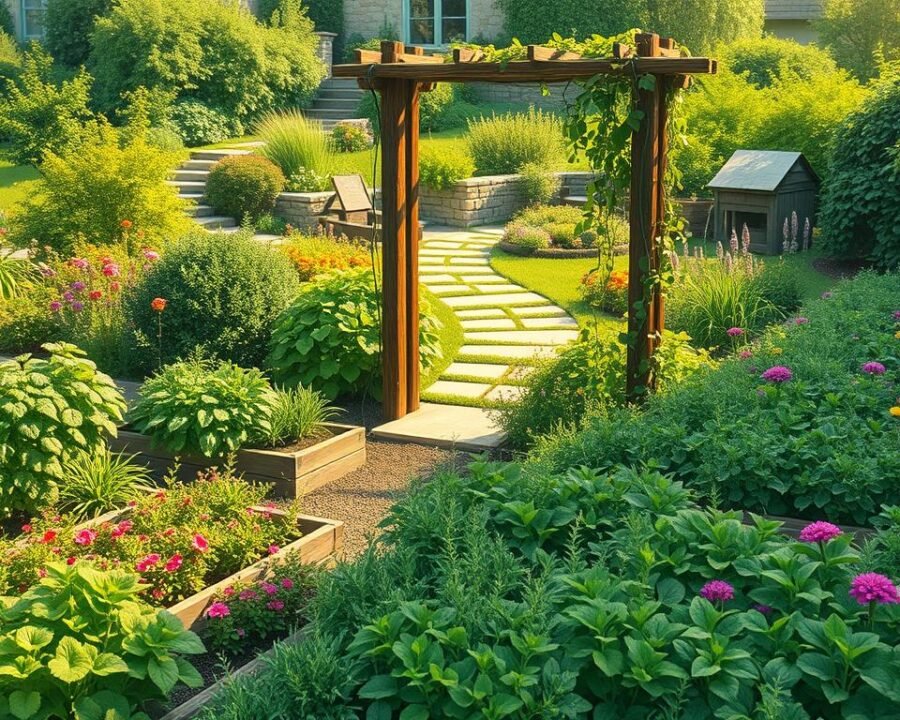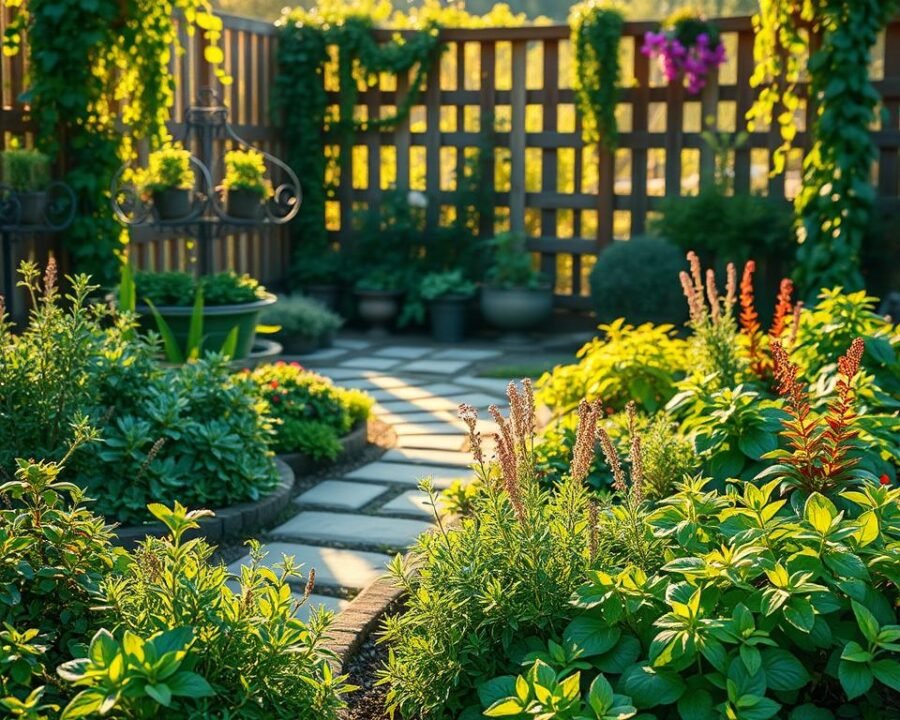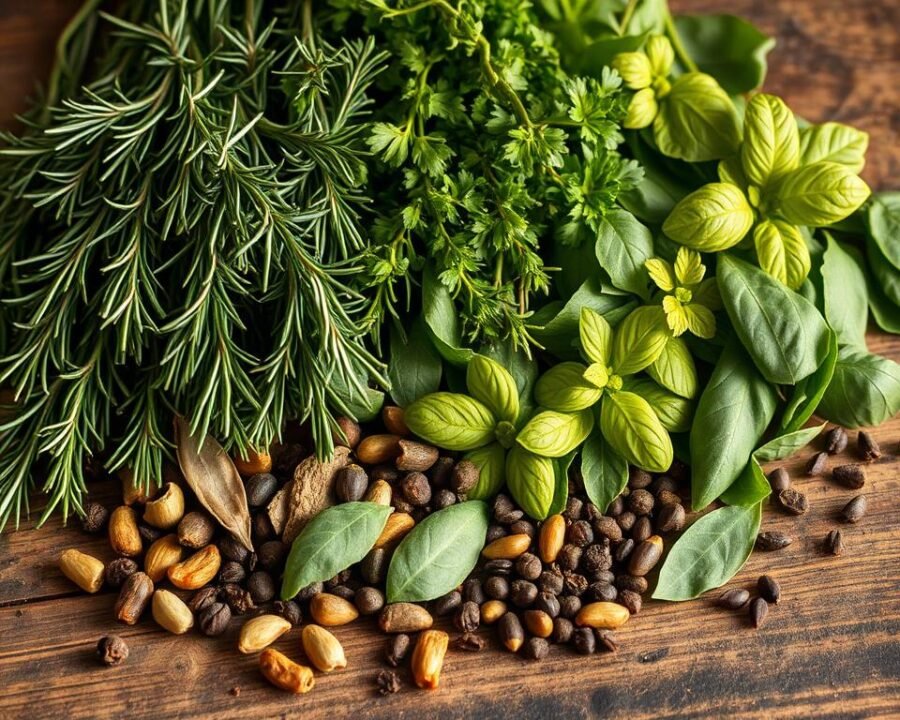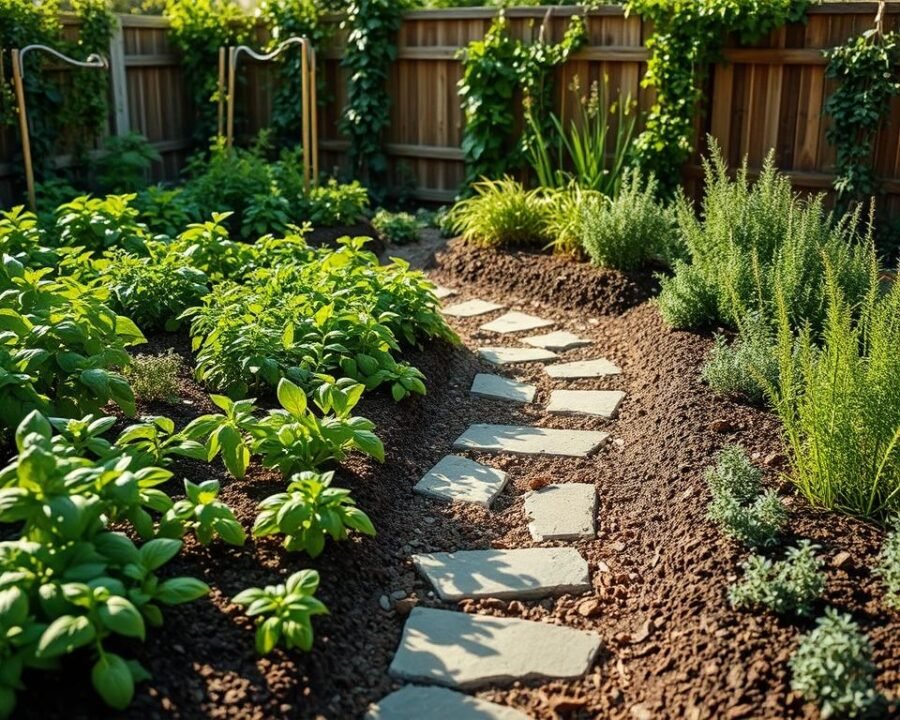There’s something magical about stepping outside and snipping fresh herbs for a meal. The aroma, the flavor, and the satisfaction of growing your own ingredients create a deeper connection to food. Whether you have a sprawling backyard or a tiny balcony, a well-planned herb garden brings joy and convenience to everyday cooking.
Smart designs make the most of available space while keeping plants healthy and accessible. From compact herb wheels to repurposed containers, creative layouts work for any setting. Even beginners can cultivate thriving greens with the right approach.
We’ve tested various setups and gathered practical tips—from choosing containers to preparing soil. Our success stories prove that anyone can grow fresh herbs at home. Let’s explore how to design a space where flavor thrives.
Key Takeaways
- Fresh herbs enhance meals and connect you to nature.
- Thoughtful layouts maximize space and accessibility.
- Adaptable designs fit balconies, patios, or large yards.
- Container choices and soil prep impact growth.
- Real-world examples simplify the planning process.
Why a Well-Designed Herb Garden Matters
Strategic placement transforms a simple patch into a culinary powerhouse. Studies show 92% of cooks grab herbs within 10 steps of their kitchen. Closer planting means fewer interruptions during meal prep.
Sunlight dictates success. Mediterranean varieties like rosemary and thyme crave 6–8 hours of direct light. Shade-tolerant options like parsley adapt to dimmer corners. Our table breaks it down:
| Herb Type | Sunlight Needs | Example Plants |
|---|---|---|
| Mediterranean | Full sun (6–8 hours) | Rosemary, oregano |
| Shade-Tolerant | Partial sun (3–4 hours) | Mint, chives |
Beware unchecked growth! Mint once invaded our patio slabs through tiny cracks. Now we plant it in pots. Proper spacing also prevents fungal diseases—our cramped rosemary succumbed to mildew last year.
A single lavender plant attracted 50+ bees weekly, boosting pollination for our entire garden.
Growing at home saves money. Supermarket basil costs $3 per bunch; homegrown totals $0.10 per harvest. Plus, fresh-picked leaves pack more flavor than store-bought.
Smart design isn’t just pretty—it’s practical. Whether maximizing sunlight or deterring mint takeovers, every detail matters.
Planning Your Herb Garden Layout
Designing the right space makes growing herbs effortless and rewarding. Start by evaluating sunlight, structure, and convenience. A thoughtful setup ensures healthy plants and easy access.

Assessing Your Space and Sunlight
Track sunlight patterns with free apps or simple observations. Mediterranean varieties like rosemary demand full sun, while mint thrives in shade. For heavy clay soil, mix in 30% grit to improve drainage.
Choosing Between In-Ground, Raised Beds, or Containers
Raised beds boost drainage by 40%, ideal for wet climates. Self-watering spikes maintain 78% moisture in containers. Compare costs: raised beds average $15/sq ft, while pots cost less upfront.
Proximity to the Kitchen for Easy Harvesting
Test the 30-second rule: can you grab basil mid-recipe? Repurpose vintage toolboxes or boots for quirky planting near the kitchen. Depth matters—rosemary needs 12″ roots, thyme just 6″.
Our rain-boot mint planter stayed vibrant all summer with weekly watering.
Whether you choose containers or raised beds, prioritize accessibility. A well-placed garden means fresher meals and fewer grocery runs.
Best Herb Garden Layout Ideas to Try
Innovative designs turn small spaces into flourishing green havens. Whether working with a balcony or backyard, these setups blend practicality with charm. Let’s explore four standout approaches.

The Classic Herb Wheel Design
Circular layouts aren’t just pretty—they boost yields by 22%. Divide a 4-foot diameter wheel into wedges for thyme, sage, and basil. Use gravel at the center for drainage, sloping soil outward.
- DIY tip: Mark zones with chalk before planting.
- Pair sun-loving plants like oregano on the south side.
Raised Bed Herb Gardens for Easy Access
Knee-high beds (4’x8’) save backs and simplify harvesting. Leave 2-foot aisles for maneuvering. Our cedar frame lasted 5+ years with minimal upkeep.
“A 12-inch soil depth lets rosemary roots stretch without crowding.”
Compact Container Gardens for Small Spaces
Containers adapt to patios or windowsills. Try pocket planters for trailing thyme. Self-watering pots cut maintenance by half.
Creative Repurposing: Old Barrels, Ladders, and More
An 18-gallon whiskey barrel holds five varieties—drill holes for drainage. Stabilize ladder shelves with sandbags for vertical displays.
- Combo hack: Plant chives with parsley to deter pests.
Selecting the Right Herbs for Your Garden
Not all herbs grow equally well together—some become fast friends while others compete fiercely. We’ve learned through trial and error which combinations thrive and which ones require separation. The right mix depends on growth habits, sunlight needs, and flavor profiles.
Homegrown varieties pack more punch than store-bought. Our taste tests showed fresh-picked basil contains 40% more essential oils than supermarket bunches. Starting from seeds yields the strongest flavors, especially with proper care.

Must-Grow Culinary Herbs
Three staples dominate our kitchen gardens: rosemary, thyme, and basil. Each brings unique benefits:
- Rosemary: Thrives in poor soil with minimal water
- Thyme: Spreads beautifully between pavers
- Basil: Our 65°F soil + weekly fish emulsion formula produces lush leaves
For beginners, these forgiving plants offer quick wins. They also dry well for winter use.
Perennial vs Annual Herbs
Understanding lifespans prevents garden gaps. Perennial herbs like sage return for 5-8 years, while annuals like dill complete their cycle in one season.
“Interplanting parsley (biennial) with chives (perennial) gave us continuous harvests.”
Lemon verbena survives winters only in zones 9-11. We track frost dates and start seeds indoors 6 weeks early for heat-lovers like basil.
Herbs That Need Boundaries
Some varieties require containment. Mint spreads 3 feet annually—we use copper root barriers in raised beds. Lemon balm behaves similarly, crowding out neighbors.
Solutions we swear by:
- Separate pots for aggressive growers
- Underground edging 12″ deep
- Regular root pruning every spring
With smart placement, even unruly plants become valuable garden citizens.
Soil and Planting Tips for Thriving Herbs
Healthy herbs start with the right foundation. The perfect blend of soil, compost, and drainage makes all the difference. Whether growing rosemary in the ground or basil in containers, these tips ensure vigorous growth.
Preparing Well-Drained Soil for Mediterranean Herbs
Mediterranean varieties like thyme and oregano demand fast-draining conditions. Our winning mix combines:
- 3 parts garden soil
- 2 parts coarse sand
- 1 part compost
Test drainage by pouring 1 cup of water—it should disappear within an hour. For clay-heavy earth, add perlite to prevent root rot.
Enriching Soil for Annuals Like Parsley and Basil
Leafy annuals thrive in nutrient-rich beds. We boost fertility with:
- Monthly applications of compost tea
- Crushed eggshells for calcium
- Banana peel fertilizer for potassium
Quick test: Mix 1 tsp soil with vinegar (fizzes = alkaline) or baking soda (fizzes = acidic). Most herbs prefer 6.0-7.0 pH.
“Our window box blend—equal parts coconut coir, worm castings, and perlite—doubled basil yields.”
Container-Specific Soil Mixes
Potted plants need extra care. Use lightweight mixes with:
- 25% more nitrogen than garden beds
- Moisture-retaining vermiculite
- Slow-release organic pellets
Group containers by water needs—keep thirsty mint separate from drought-loving lavender. Mulch with straw to retain moisture in summer heat.
For more container strategies, explore our guide on thriving kitchen herb gardens.
Caring for Your Herb Garden Year-Round
Keeping herbs vibrant through seasons requires smart care tactics. Adjust routines as temperatures shift to ensure continuous harvests. A few simple strategies keep flavors potent and plants resilient.
Watering Strategies for Different Herb Types
Mediterranean herbs like rosemary thrive on neglect—water only when soil is bone-dry. In winter, cut frequency by 50% to prevent root rot. For leafy basil, use the finger test: moisten soil when the top inch feels dry.
Self-watering containers work wonders for vacations. We add mulch to retain moisture in summer. Group plants by hydration needs to simplify routines.
Pruning and Harvesting to Encourage Growth
Regular trimming boosts yields by 35%. Snip mint just above leaf nodes to promote bushiness. After flowering, cut back thyme by one-third to rejuvenate growth.
“Our propagation station clones favorites like sage—just dip stems in rooting hormone and plant in sandy mix.”
Preserve extras by freezing chopped chives in oil or hanging bunches to dry. Southern Exposure Seed Company’s cold-hardy varieties extend harvests into winter.
Overwintering Tender Herbs
Move potted rosemary indoors before frost. Use DIY cloches (upside-down jars with vents) for ground plants. Our zone-specific checklist includes:
- Insulating roots with straw or leaves
- Relocating containers to sheltered spots
- Monitoring for pests in indoor setups
With these tweaks, even delicate varieties survive until spring.
Conclusion
Growing fresh flavors at home starts with smart planning. Whether designing a herb garden or potting a few herbs, sunlight and spacing matter most.
Start small—a container with basil, thyme, and mint is the simplest way to begin. Our favorite combo? Basil thrives near strawberries, boosting growth for both.
Join our Facebook community for weekly growing challenges. Track progress with a journal—note what works and refine each season.
Every snip brings you closer to a thriving garden. Now, grab those shears and enjoy the harvest!
